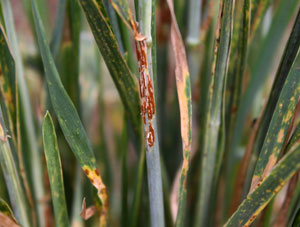 CIMMYT-led international efforts to identify and deploy sources of resistance to the virulent Ug99 strain of stem rust have received coverage on ABC1, the primary television channel of the Australian Broadcasting Corporation.
CIMMYT-led international efforts to identify and deploy sources of resistance to the virulent Ug99 strain of stem rust have received coverage on ABC1, the primary television channel of the Australian Broadcasting Corporation.
Stem rust spores, carried large distances by the wind, are no respecters of borders. The battle against the disease is one which requires global collaboration—and is attracting global media interest. “Wheat is our most important crop and [stem rust] is arguably the most damaging of all the pathogens of wheat, it destroys crops,” explained Professor Robert Park of the University of Sydney’s Plant Breeding Institute in an episode of Catalyst, ABC’s flagship science series, aired on 04 August 2011.
Ug99 is able to overcome the resistance of popular wheat varieties, making this new stem rust a major threat to world food security. In East Africa, where Ug99 first emerged, it has devastated smallholder wheat crops. ABC’s reporter Paul Willis visited the Njoro research station in Kenya, where the Kenya Agricultural Research Institute (KARI) hosts a large-scale program now screening around 30,000 wheat lines from all over the world each year—including those brought from Australia by Park.
“What we’ve got here is materials that we receive from several developing countries. As you can see there’s Australia, there’s China, Nepal, Bangladesh. So everyone wants to test their material and see if it is actually resistant to Ug99,” said CIMMYT molecular breeder Sridhar Bhavani, pointing out plots of wheat in the field at Njoro.
Working together, scientists have made substantial process in understanding Ug99 resistance and developing new wheats. “So far we’ve characterised close to about fifty genes for stem rust resistance,” said Bhavani. Producing suitable varieties and getting them to farmers is an ongoing challenge, but Willis strikes an optimistic note: “This looks like the hope for the future. It’s a strain of wheat called “King Bird” that was developed by CIMMYT and is now deployed all around the world. And it looks like it’s got very high levels of resistance against Ug99.”
The complete video clip, with transcript, is available at: http://www.abc.net.au/catalyst/stories/3285577.htm